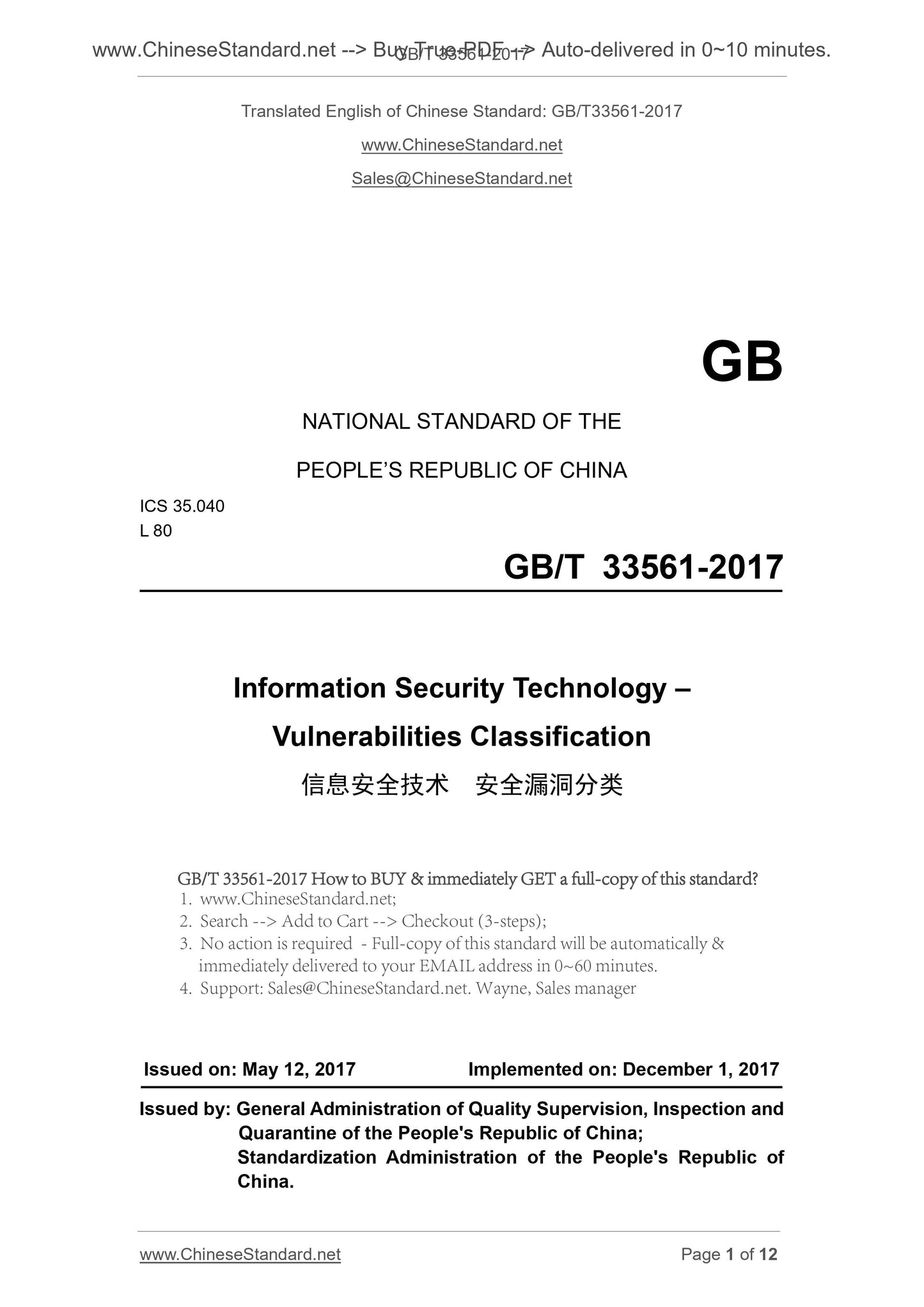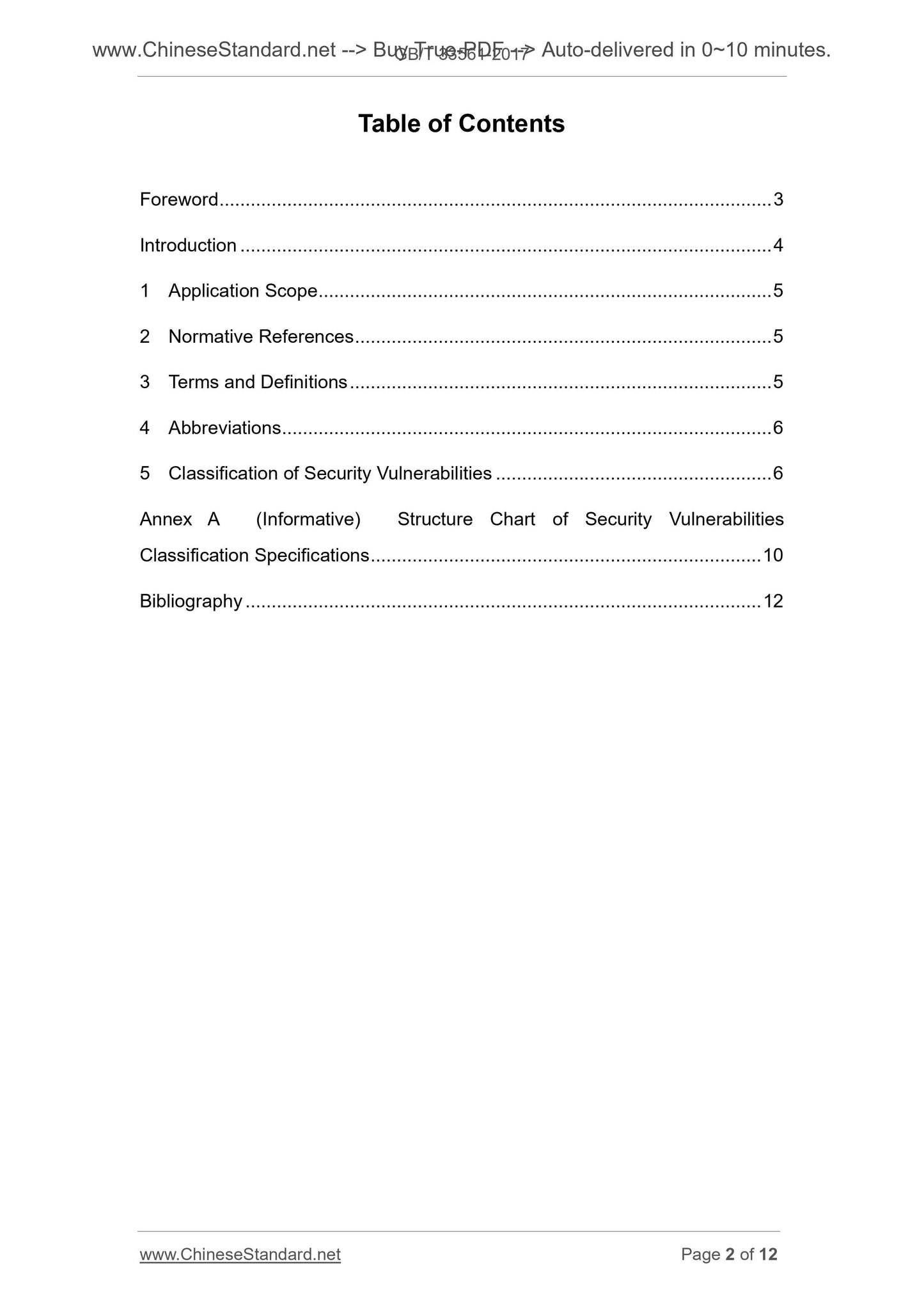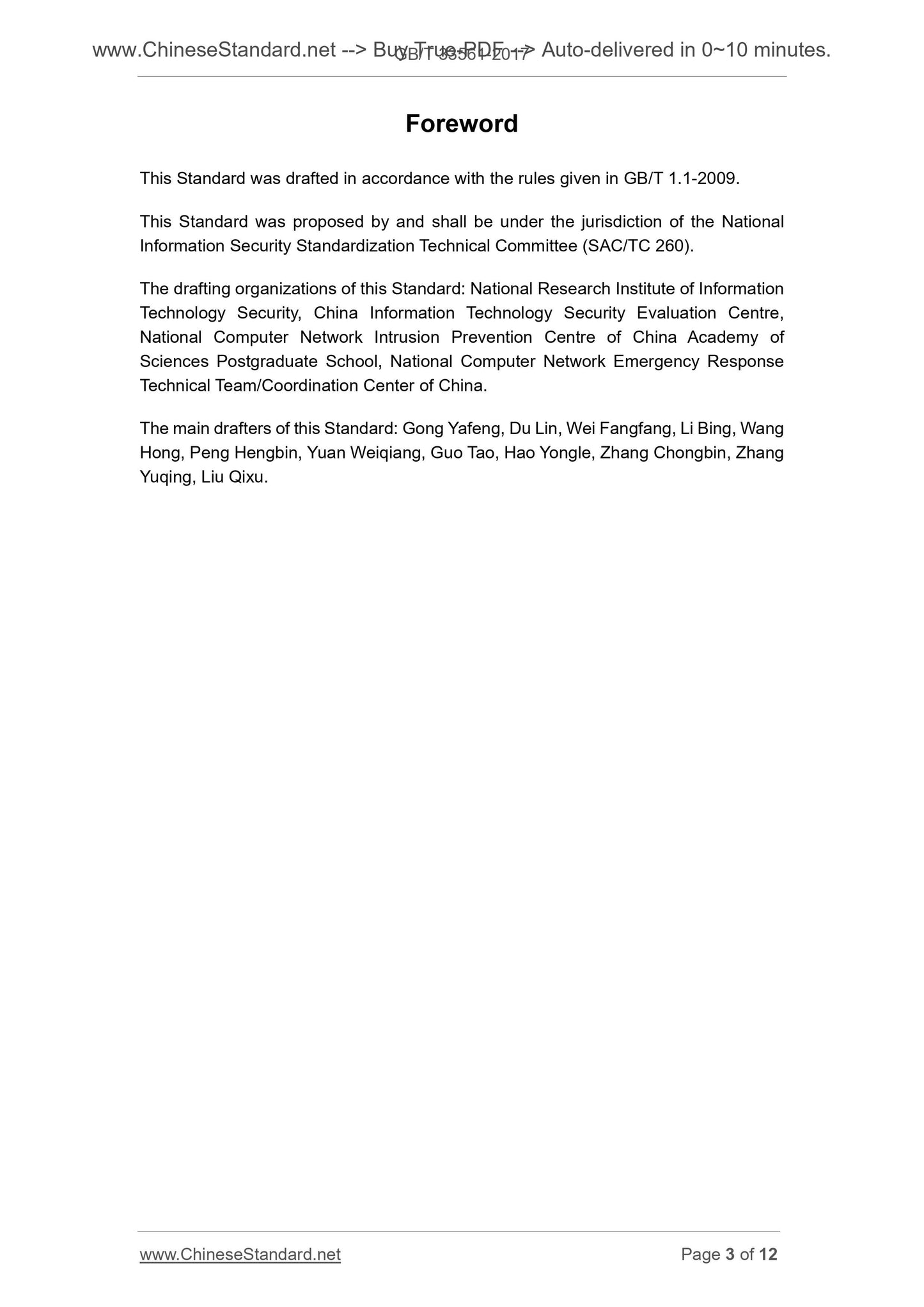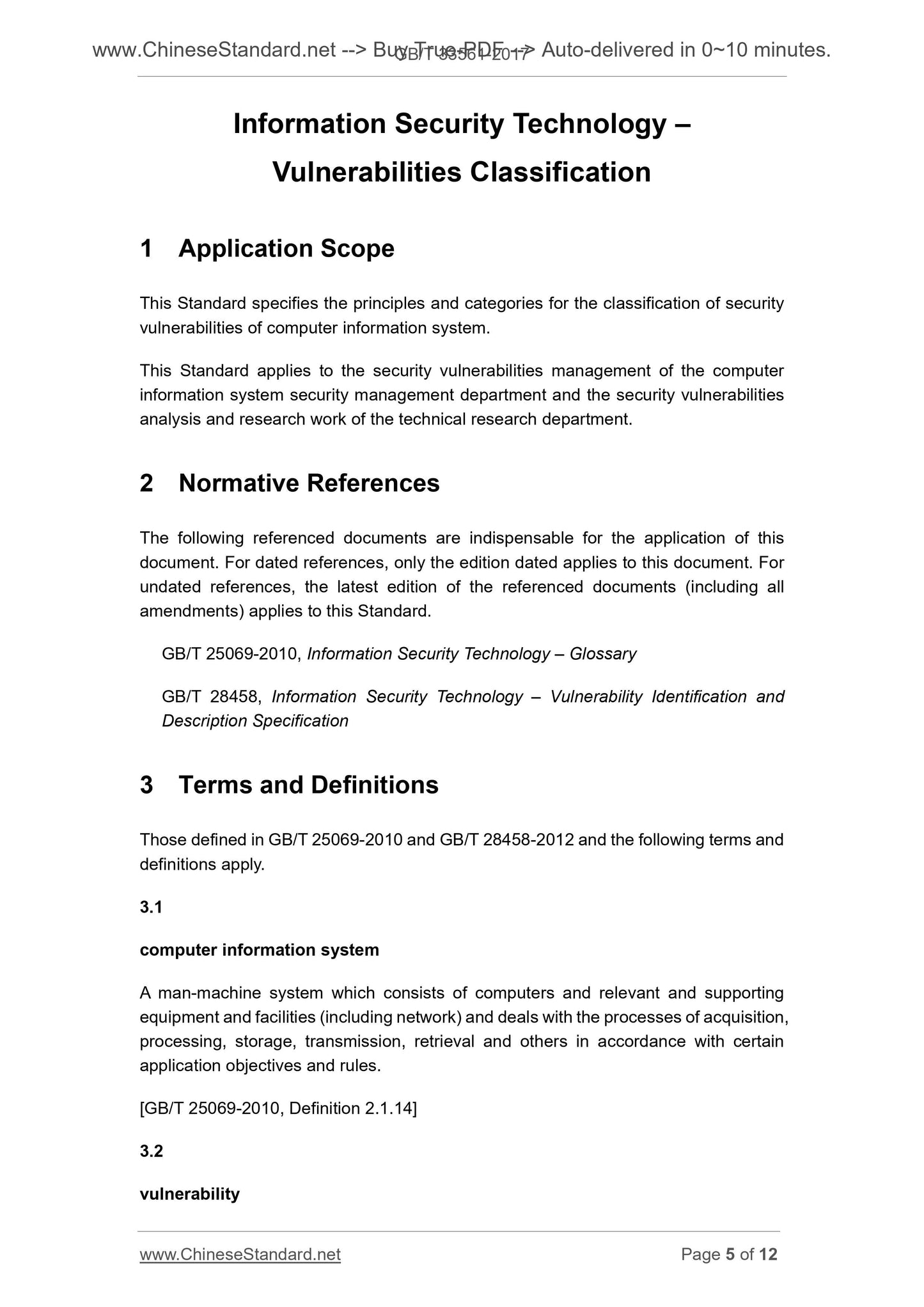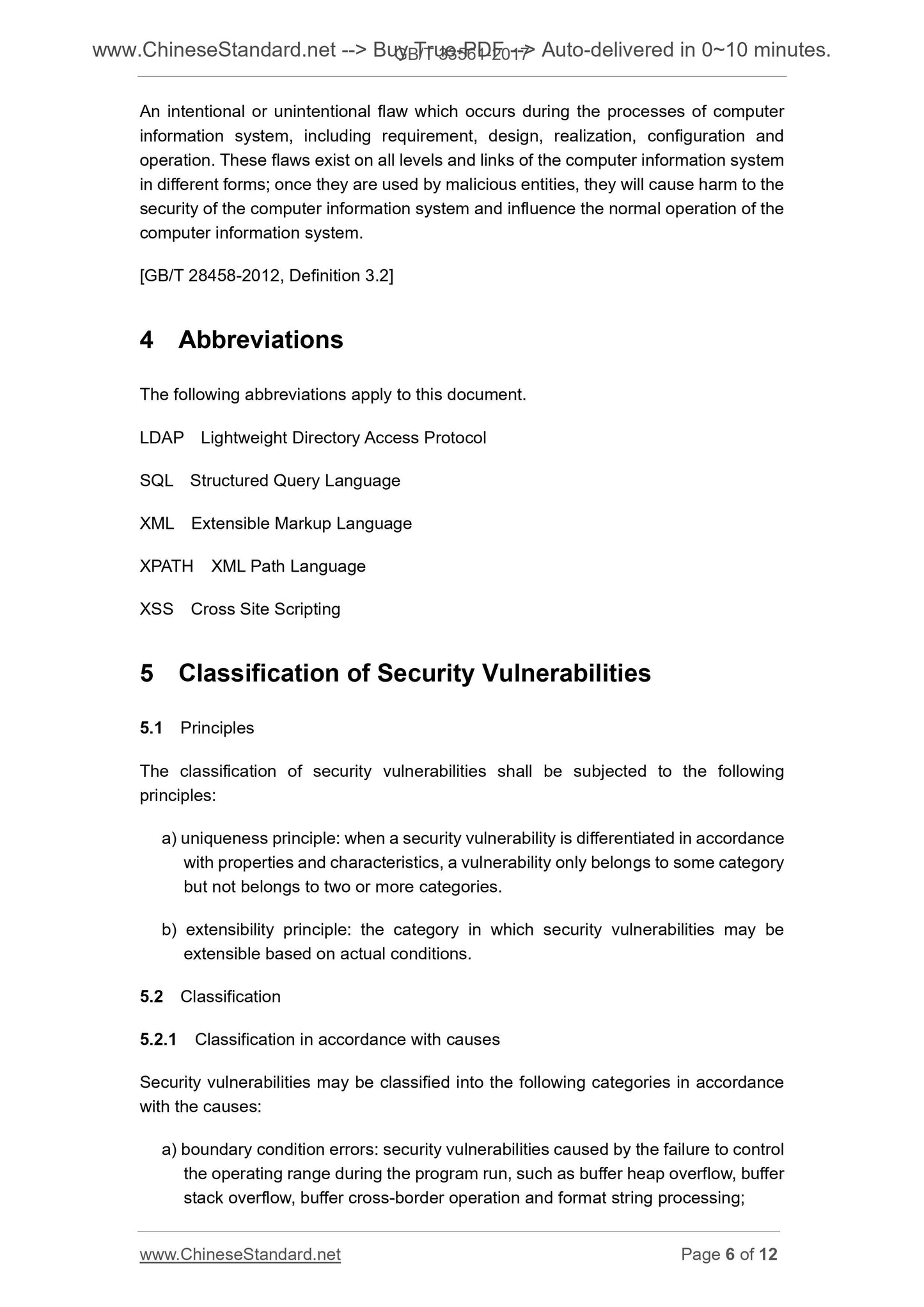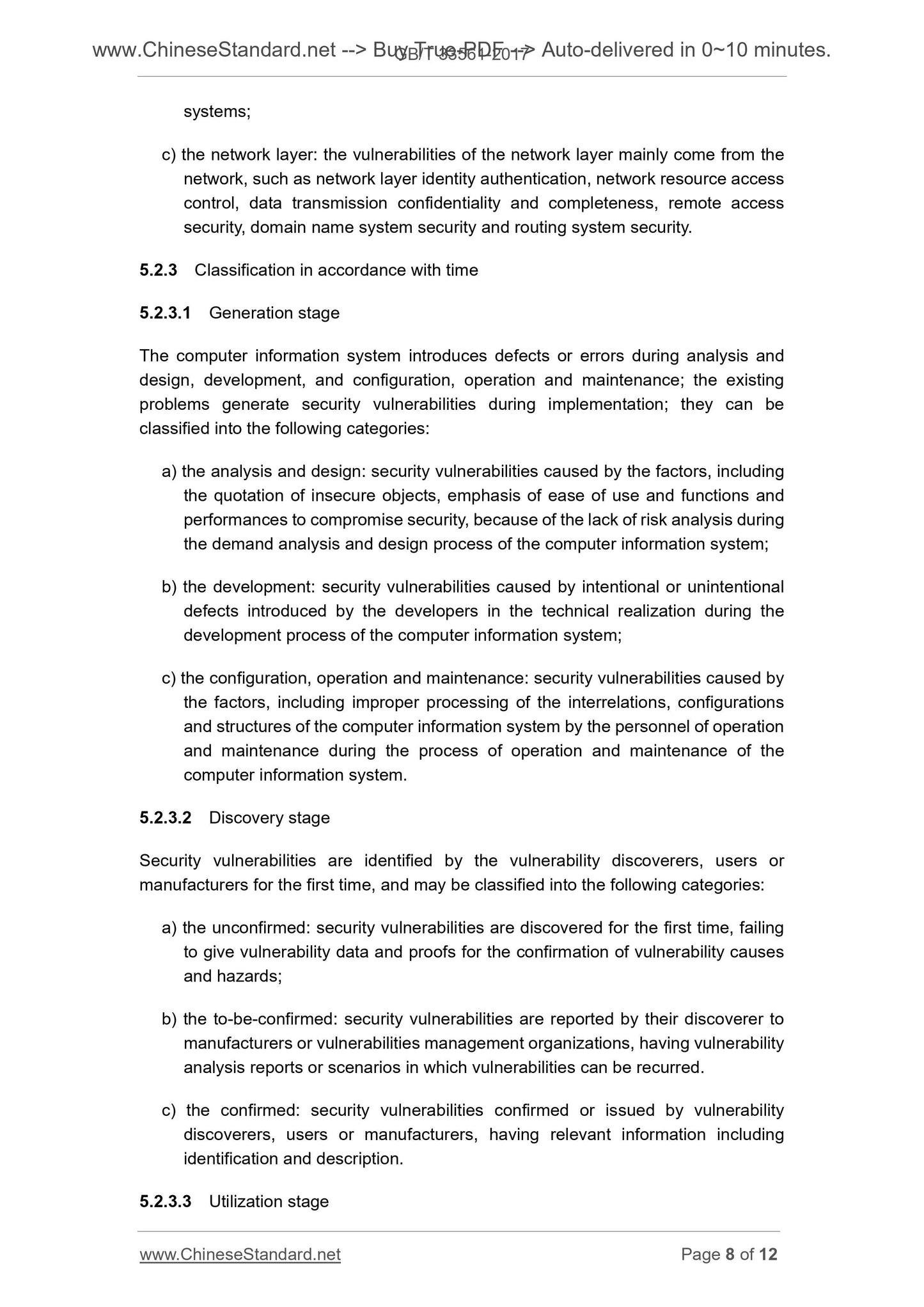1
/
of
6
PayPal, credit cards. Download editable-PDF & invoice in 1 second!
GB/T 33561-2017 English PDF (GBT33561-2017)
GB/T 33561-2017 English PDF (GBT33561-2017)
Regular price
$140.00 USD
Regular price
Sale price
$140.00 USD
Unit price
/
per
Shipping calculated at checkout.
Couldn't load pickup availability
Delivery: 3 seconds. Download true-PDF + Invoice.
Get QUOTATION in 1-minute: Click GB/T 33561-2017
Historical versions: GB/T 33561-2017
Preview True-PDF (Reload/Scroll if blank)
GB/T 33561-2017: Information security technology -- Vulnerabilities classification
GB/T 33561-2017
GB
NATIONAL STANDARD OF THE
PEOPLE’S REPUBLIC OF CHINA
ICS 35.040
L 80
Information Security Technology –
Vulnerabilities Classification
ISSUED ON. MAY 12, 2017
IMPLEMENTED ON. DECEMBER 1, 2017
Issued by. General Administration of Quality Supervision, Inspection and
Quarantine of the People's Republic of China;
Standardization Administration of the People's Republic of
China.
3. No action is required - Full-copy of this standard will be automatically and
immediately delivered to your EMAIL address in 0~60 minutes.
Table of Contents
Foreword ... 3
Introduction ... 4
1 Application Scope ... 5
2 Normative References ... 5
3 Terms and Definitions ... 5
4 Abbreviations ... 6
5 Classification of Security Vulnerabilities ... 6
Annex A (Informative) Structure Chart of Security Vulnerabilities
Classification Specifications ... 10
Bibliography ... 12
Foreword
This Standard was drafted in accordance with the rules given in GB/T 1.1-2009.
This Standard was proposed by and shall be under the jurisdiction of the National
Information Security Standardization Technical Committee (SAC/TC 260).
The drafting organizations of this Standard. National Research Institute of Information
Technology Security, China Information Technology Security Evaluation Centre,
National Computer Network Intrusion Prevention Centre of China Academy of
Sciences Postgraduate School, National Computer Network Emergency Response
Technical Team/Coordination Center of China.
The main drafters of this Standard. Gong Yafeng, Du Lin, Wei Fangfang, Li Bing, Wang
Hong, Peng Hengbin, Yuan Weiqiang, Guo Tao, Hao Yongle, Zhang Chongbin, Zhang
Yuqing, Liu Qixu.
Information Security Technology –
Vulnerabilities Classification
1 Application Scope
This Standard specifies the principles and categories for the classification of security
vulnerabilities of computer information system.
This Standard applies to the security vulnerabilities management of the computer
information system security management department and the security vulnerabilities
analysis and research work of the technical research department.
2 Normative References
The following referenced documents are indispensable for the application of this
document. For dated references, only the edition dated applies to this document. For
undated references, the latest edition of the referenced documents (including all
amendments) applies to this Standard.
GB/T 25069-2010, Information Security Technology – Glossary
GB/T 28458, Information Security Technology – Vulnerability Identification and
Description Specification
3 Terms and Definitions
Those defined in GB/T 25069-2010 and GB/T 28458-2012 and the following terms and
definitions apply.
3.1
computer information system
A man-machine system which consists of computers and relevant and supporting
equipment and facilities (including network) and deals with the processes of acquisition,
processing, storage, transmission, retrieval and others in accordance with certain
application objectives and rules.
[GB/T 25069-2010, Definition 2.1.14]
3.2
vulnerability
An intentional or unintentional flaw which occurs during the processes of computer
information system, including requirement, design, realization, configuration and
operation. These flaws exist on all levels and links of the computer information system
in different forms; once they are used by malicious entities, they will cause harm to the
security of the computer information system and influence the normal operation of the
computer information system.
[GB/T 28458-2012, Definition 3.2]
4 Abbreviations
The following abbreviations apply to this document.
LDAP Lightweight Directory Access Protocol
SQL Structured Query Language
XML Extensible Markup Language
XPATH XML Path Language
XSS Cross Site Scripting
5 Classification of Security Vulnerabilities
5.1 Principles
The classification of security vulnerabilities shall be subjected to the following
principles.
a) uniqueness principle. when a security vulnerability is differentiated in accordance
with properties and characteristics, a vulnerability only belongs to some category
but not belongs to two or more categories.
b) extensibility principle. the category in which security vulnerabilities may be
extensible based on actual conditions.
5.2 Classification
5.2.1 Classification in accordance with causes
Security vulnerabilities may be classified into the following categories in accordance
with the causes.
a) boundary condition errors. security vulnerabilities caused by the failure to control
the operating range during the program run, such as buffer heap overflow, buffer
stack overflow, buffer cross-border operation and format string processing;
systems;
c) the network layer. the vulnerabilities of the network layer mainly come from the
network, such as network layer identity authentication, network resource access
control, data transmission confidentiality and completeness, remote access
security, domain name system security and routing system security.
5.2.3 Classification in accordance with time
5.2.3.1 Generation stage
The computer information system introduces defects or errors during analysis and
design, development, and configuration, operation and maintenance; the existing
problems generate security vulnerabilities during implementation; they can be
classified into the following categories.
a) the analysis and design. security vulnerabilities caused by the factors, including
the quotation of insecure objects, emphasis of ease of use and functions and
performances to compromise security, because of the lack of risk analysis during
the demand analysis and design process of the computer information system;
b) the development. security vulnerabilities caused by intentional or unintentional
defects introduced by the developers in the technical realization during the
development process of the computer information system;
c) the configuration, operation and maintenance. security vulnerabilities caused by
the factors, including improper processing of the interrelations, configurations
and structures of the computer information system by the personnel of operation
and maintenance during the process of operation and maintenance of the
computer information system.
5.2.3.2 Discovery stage
Security vulnerabilities are identified by the vulnerability discoverers, users or
manufacturers for the first time, and may be classified into the following categories.
a) the unconfirmed. security vulnerabilities are discovered for the first time, failing
to give vulnerability data and proofs for the confirmation of vulnerability causes
and hazards;
b) the to-be-confirmed. security vulnerabilities are reported by their discoverer to
manufacturers or vulnerabilities management organizations, having vulnerability
analysis reports or scenarios in which vulnerabilities can be recurred.
c) the confirmed. security vulnerabilities confirmed or issued by vulnerability
discoverers, users or manufacturers, having relevant information including
identification and description.
5.2.3.3 Utilization stage
Get QUOTATION in 1-minute: Click GB/T 33561-2017
Historical versions: GB/T 33561-2017
Preview True-PDF (Reload/Scroll if blank)
GB/T 33561-2017: Information security technology -- Vulnerabilities classification
GB/T 33561-2017
GB
NATIONAL STANDARD OF THE
PEOPLE’S REPUBLIC OF CHINA
ICS 35.040
L 80
Information Security Technology –
Vulnerabilities Classification
ISSUED ON. MAY 12, 2017
IMPLEMENTED ON. DECEMBER 1, 2017
Issued by. General Administration of Quality Supervision, Inspection and
Quarantine of the People's Republic of China;
Standardization Administration of the People's Republic of
China.
3. No action is required - Full-copy of this standard will be automatically and
immediately delivered to your EMAIL address in 0~60 minutes.
Table of Contents
Foreword ... 3
Introduction ... 4
1 Application Scope ... 5
2 Normative References ... 5
3 Terms and Definitions ... 5
4 Abbreviations ... 6
5 Classification of Security Vulnerabilities ... 6
Annex A (Informative) Structure Chart of Security Vulnerabilities
Classification Specifications ... 10
Bibliography ... 12
Foreword
This Standard was drafted in accordance with the rules given in GB/T 1.1-2009.
This Standard was proposed by and shall be under the jurisdiction of the National
Information Security Standardization Technical Committee (SAC/TC 260).
The drafting organizations of this Standard. National Research Institute of Information
Technology Security, China Information Technology Security Evaluation Centre,
National Computer Network Intrusion Prevention Centre of China Academy of
Sciences Postgraduate School, National Computer Network Emergency Response
Technical Team/Coordination Center of China.
The main drafters of this Standard. Gong Yafeng, Du Lin, Wei Fangfang, Li Bing, Wang
Hong, Peng Hengbin, Yuan Weiqiang, Guo Tao, Hao Yongle, Zhang Chongbin, Zhang
Yuqing, Liu Qixu.
Information Security Technology –
Vulnerabilities Classification
1 Application Scope
This Standard specifies the principles and categories for the classification of security
vulnerabilities of computer information system.
This Standard applies to the security vulnerabilities management of the computer
information system security management department and the security vulnerabilities
analysis and research work of the technical research department.
2 Normative References
The following referenced documents are indispensable for the application of this
document. For dated references, only the edition dated applies to this document. For
undated references, the latest edition of the referenced documents (including all
amendments) applies to this Standard.
GB/T 25069-2010, Information Security Technology – Glossary
GB/T 28458, Information Security Technology – Vulnerability Identification and
Description Specification
3 Terms and Definitions
Those defined in GB/T 25069-2010 and GB/T 28458-2012 and the following terms and
definitions apply.
3.1
computer information system
A man-machine system which consists of computers and relevant and supporting
equipment and facilities (including network) and deals with the processes of acquisition,
processing, storage, transmission, retrieval and others in accordance with certain
application objectives and rules.
[GB/T 25069-2010, Definition 2.1.14]
3.2
vulnerability
An intentional or unintentional flaw which occurs during the processes of computer
information system, including requirement, design, realization, configuration and
operation. These flaws exist on all levels and links of the computer information system
in different forms; once they are used by malicious entities, they will cause harm to the
security of the computer information system and influence the normal operation of the
computer information system.
[GB/T 28458-2012, Definition 3.2]
4 Abbreviations
The following abbreviations apply to this document.
LDAP Lightweight Directory Access Protocol
SQL Structured Query Language
XML Extensible Markup Language
XPATH XML Path Language
XSS Cross Site Scripting
5 Classification of Security Vulnerabilities
5.1 Principles
The classification of security vulnerabilities shall be subjected to the following
principles.
a) uniqueness principle. when a security vulnerability is differentiated in accordance
with properties and characteristics, a vulnerability only belongs to some category
but not belongs to two or more categories.
b) extensibility principle. the category in which security vulnerabilities may be
extensible based on actual conditions.
5.2 Classification
5.2.1 Classification in accordance with causes
Security vulnerabilities may be classified into the following categories in accordance
with the causes.
a) boundary condition errors. security vulnerabilities caused by the failure to control
the operating range during the program run, such as buffer heap overflow, buffer
stack overflow, buffer cross-border operation and format string processing;
systems;
c) the network layer. the vulnerabilities of the network layer mainly come from the
network, such as network layer identity authentication, network resource access
control, data transmission confidentiality and completeness, remote access
security, domain name system security and routing system security.
5.2.3 Classification in accordance with time
5.2.3.1 Generation stage
The computer information system introduces defects or errors during analysis and
design, development, and configuration, operation and maintenance; the existing
problems generate security vulnerabilities during implementation; they can be
classified into the following categories.
a) the analysis and design. security vulnerabilities caused by the factors, including
the quotation of insecure objects, emphasis of ease of use and functions and
performances to compromise security, because of the lack of risk analysis during
the demand analysis and design process of the computer information system;
b) the development. security vulnerabilities caused by intentional or unintentional
defects introduced by the developers in the technical realization during the
development process of the computer information system;
c) the configuration, operation and maintenance. security vulnerabilities caused by
the factors, including improper processing of the interrelations, configurations
and structures of the computer information system by the personnel of operation
and maintenance during the process of operation and maintenance of the
computer information system.
5.2.3.2 Discovery stage
Security vulnerabilities are identified by the vulnerability discoverers, users or
manufacturers for the first time, and may be classified into the following categories.
a) the unconfirmed. security vulnerabilities are discovered for the first time, failing
to give vulnerability data and proofs for the confirmation of vulnerability causes
and hazards;
b) the to-be-confirmed. security vulnerabilities are reported by their discoverer to
manufacturers or vulnerabilities management organizations, having vulnerability
analysis reports or scenarios in which vulnerabilities can be recurred.
c) the confirmed. security vulnerabilities confirmed or issued by vulnerability
discoverers, users or manufacturers, having relevant information including
identification and description.
5.2.3.3 Utilization stage
Share
